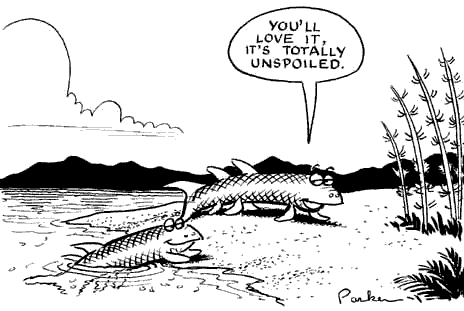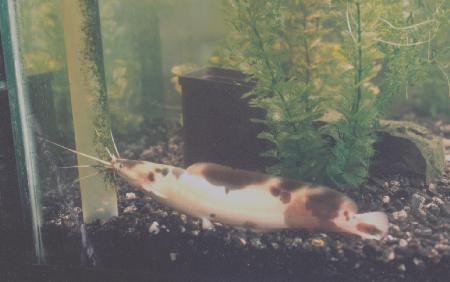SCOTCAT.COM
your internet guide to all things catfish
| Thoughts on a Catfish |
by John Sankey |
They are true fish. But, they
breath air!
One species, Clarias batrachus, is occasionally found in tropical fish stores. It has a body shaped like a fish, scaleless like an amphibian, and four pairs of barbels. It comes in a wide variety of colours: white, tan, gray, brown, or albino. Males have spots on their dorsal fin and females don't. It moves on land by curling its tail forward then jumping, like a frog with only one rear leg, keeping itself upright with its stiff front fins. Mine is less than a foot long, but can move so fast it might get away from me if I don't have a butterfly net in hand. Clarias are not appreciated by fastidious aquarists, for they dismember and eat any fish smaller than they are. It's not a quick process either. Clarias have a small mouth, with no teeth - their prey has to be reduced to swallowing size by shaking. They normally live on muddy bottoms, and can't see more than a few centimetres, so they have to locate food almost entirely by smell and motion. And, in the artificial environment of a small aquarium, smells can spread so evenly that even that fails to help them locate food - they have to just charge around until they run into it. I feed mine dried food, and earwigs in season.
They are also a useful example of the resilience of biodiverse ecosystems. The June 1969 National Geographic (135:846-851) contains photos of the panic-driven campaign that occurred when they were discovered in the Everglades. The living things of thousands of pools were killed with rotenone until it was discovered that everything except the catfish were being killed - they simply climbed out of the poisoned pools and walked to the next one. The campaign was abandoned - the Everglades given up as lost forever by the authorities. Then, it was discovered that alligators love Clarias - the alligators of the Everglades have never been better fed! I am not aware of a single species whose existence in the Everglades was endangered by the addition of Clarias. (Incidentally, the same is true of house sparrows, starlings and purple loosestrife, all of which have engendered equally panic-stricken campaigns around me in Canada.) As do all experienced aquarists, I underfeed rather than overfeed for best health. However, when Clarias feel underfed, they try to head for the next pond, by thumping and pushing on the aquarium cover. Once out of the aquarium, they will roam a building in search of an exit until they are almost totally desiccated. (Or, meet a household cat or dog - they are helpless to defend themselves on land.) They are strong fish - I've got a weight on the cover! They grow to 40 cm long,
so need a large aquarium - 150 litres or more. The
pH should be slightly acidic, 6.5-7.0, and water
temperature 15-25C, for best health. They are very
hardy, do not need a heater in a centrally heated
building, and eat anything usually offered to fish.
They can eat until their belly swells to the size
of a golf ball, then do without food for the next
week - no fish sitter needed. They are common in
tropical Asia and are used for food there.
|
If you would like to contribute an article, please e-mail me. You will of course be credited for your work.
If you would like to donate any denomination of money to the site just click the above link button. All proceeds will go to running the site and hopefully to keep it going for a few years yet.
Print or e-mail this factsheet below



